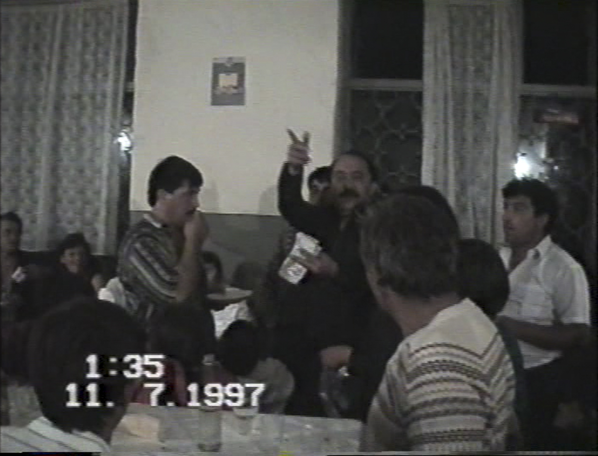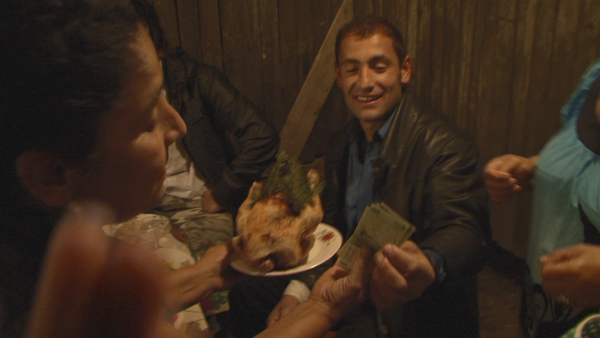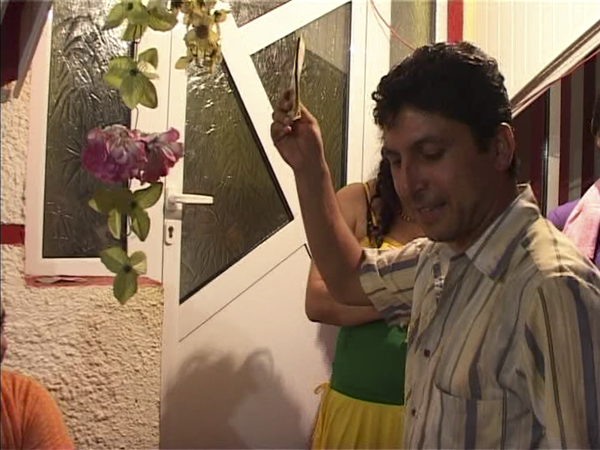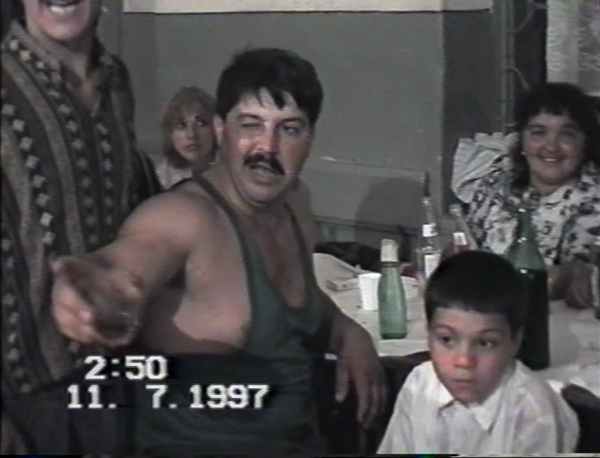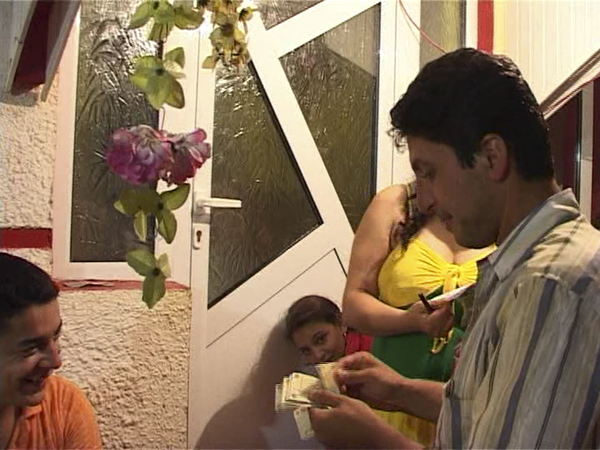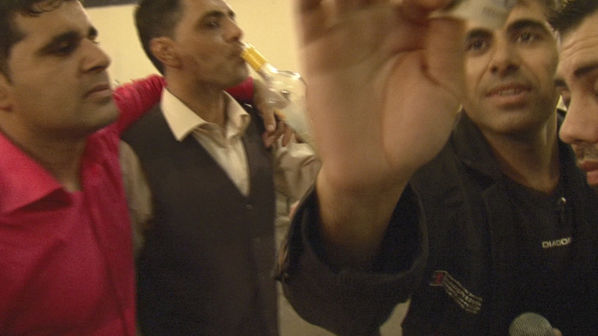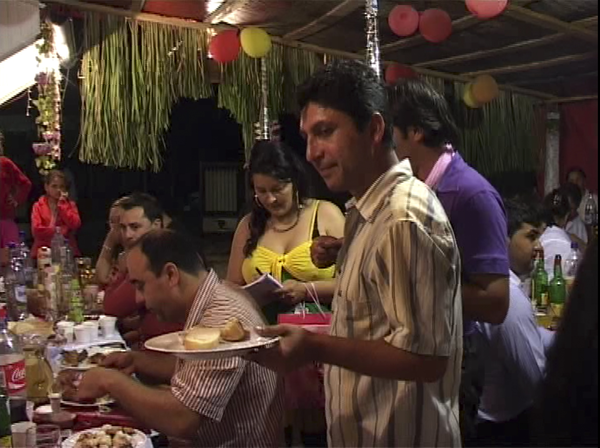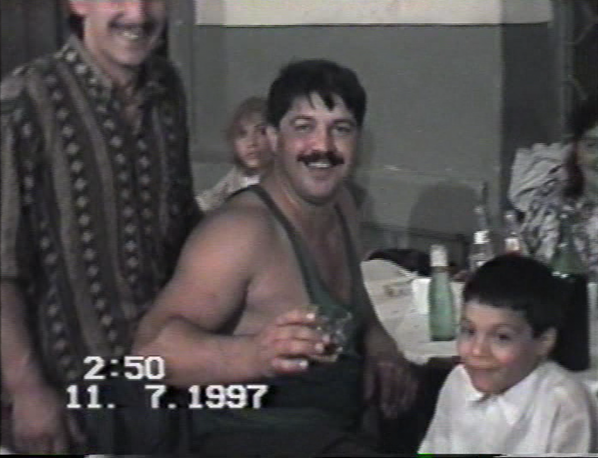Arriving for the first time in Dițești at the home of Lucian, my host for the first four years of my fieldwork, my perception of the soundscape was based on his listening. An accordionist and pianist, he quickly introduced me to his musician friends and to the small world of the lăutari. My perception of the acoustic environment of Dițești was actually in sync with the tune of this small world of musicians (lăutărie), which consists of good families (familie bune) who consider themselves as part of the social elite. These musicians strive to distinguish themselves from the pauperization and ethnicization of poverty characteristic of the țigănie without shirking the moral obligations of solidarity, shared within the community. In this first video, Tina, my client and the father of the young boy whose birthday is being celebrated, commissioned famous (Roma) musicians from Bucharest.
Tina and his wife decided to bring the lăutari to the yard of the young boy’s maternal grandmother, rather than to their own home, because of its location on the most inhabited street of the neighborhood. This way they are sure to attract more easily the onlookers who come to observe the hosting family and the musicians. They installed the massive sound system in the small space between the street and the stoop. A crowd quickly gathered, standing at the entrance of the courtyard and on the side of the road, eventually occupying a large part of the roadway. As with village bells, the volume of the loudspeakers fulfills the function of announcement. To my great surprise, the crowd that spontaneously gathered at the side of the road remained relatively impassive. Except for the young children and a few notorious alcoholics, no one in the audience spontaneously starts dancing, shouting, or even singing. The locals come to listen to the musicians (especially if they are famous or coming to Dițești for the first time), to pass the time, and to watch the various members of the celebrated family. This attention, which is only impassive in appearance, is in reality a genuine evaluation. As I later learnt from the many discussions with my interlocutors, this motionless observation and listening conceals a real evaluation: How are the bride, godparents and parents-in-law dressed? Who is present and who is not? Who are the musicians and how do they play? Who gives the tips (bacşiş), how much are they, and to whom are they dedicated?
Unaware of the fame of the troupe and the lead singer (Costel Biju), and just beginning to make my first video recordings in the field, the whole sequence is a relative failure in the eyes and ears of both the musicians and Tina. Impressed by the contrast between the mute, compact, motionless crowd and the energy deployed by Tina's family – as the volume of the speakers is pushed to the limit of distortion – I start to pan slowly. A person appears at my back, and the musicians signal me to immediately move the camera and film Tina who is giving an important “tip” to the singer. The latter lists the numerous banknotes while shouting into the microphone the dedications addressed by Tina to his relatives and guests.[3] I quickly understand from the bewildered and reproving looks of the lăutari that what matters and must be filmed is the interaction between Tina's family and them rather than the social situation as a whole. The audience is a backdrop that does not need to be highlighted. Like the lăutari, I am paid to follow my client’s directions.
The failure of the recording of this sequence is both technical and methodological: Tina, the lăutari, and I were paying attention to different aspects of the soundscape and the atmosphere. Equipped with an omnidirectional microphone without activating the bass cut and the 10dB reduction, I wanted to describe the filmed situation from the sidelines, like a filmmaker making an observational film in whom people recognize “the power to witness the totality of [the] event” (MacDougall [1975] 1998: 129). Because of the imperative communicated by the musicians to remain as close as possible to the interactions around the microphone, when my recording instruments and EQ settings are not appropriate, the sound of my first attempts is completely distorted. My client and especially his musician friends in the village express their disappointment at the poor sound quality, blaming me for not being in the business (din meserie) and paying too much attention to the audience. I will correct this later by opting for other microphone settings and a portable recorder and cutting out the scenes and frames presenting the broader context of the situation: the audience, the architecture of the neighborhood or the precise location of the house in the village. However, I do preserve these recorded elements for both my research and the documentary film I was trying to make at the time.
For my clients as well as for the musicians, a loud and clear sound is valued in the situation – and thus in the recording. The volume at the party is associated with the fame of both the lăutari and the family, which often leads the person in charge of the sound system to push the volume to the limit of feedback. The sound recording, however, is evaluated differently. For the musicians, not hearing the din (gălăgie) from the hall or the street is crucial to their own promotion or even to copying and studying the style of a renowned musician. From my second stay in Dițești, in the spring of 2008, I inflected my research and creative interests to adapt to this sound aesthetic, without, however, giving in to the demands of the lăutari who wanted me to record the cleanest sound possible (cel mai curat sunet), plugging my portable recorder directly into the mixer, as some musicians coming from Bucharest did during my fieldwork. This listening would have been too far from the experience and demand of my clients and interlocutors, who literally need to hear themselves when responding to jokes and shouts and speaking at crucial moments of the evening, particularly the ones involving money. This is especially true for the announcement of gifts offered by the guests (darul), which is sometimes done without a microphone. These announcements are particularly important for the guests because they make visible and audible not only the sums of money being offered but also the obligations (obligații) being paid or the debt (datorii) being accumulated by those present. At this particular moment, the cameraman is even asked to stand as close as possible to the guests and the person making the announcements (see images below). If the cameraman fails to do so, he is immediately called to order. This attention to the auditory experience and even to the “point of audition” (Chion [1990] 1994) of the party organizers was thus in contradiction with those of the musicians, for whom these moments were not worthy of being recorded because they were not beautiful (frumoși).[4]
In the course of my ethnographic research, I gradually came to understand the balance that needed to be maintained between these different points of audition. In 2007, all this escapes me, and the inadequacy of my position during these first images shot for Tina makes them rubbish both for him and for his musician friends. Even if the distortion and feedback recorded by the shooting device make both the fame claimed by the volume of the loudspeakers and the measured attention of the crowd particularly noticeable, the sound signal was too distorted and noisy to be used in my documentary films, and I never reused or seriously analyzed this footage. Fifteen years after producing a DVD for Tina, in accordance with our agreement, I am listening to this footage again in a different way. Indeed, of the thirty or so family celebrations filmed at the request of my interlocutors between 2007 and 2010, very few contain images that linger so long on the audience. This kind of attention, focused on the choreography of the social relations around the musicians and relatively unaffected by the volume or the melodies heard, resulted in intense conversations and spontaneous descriptions that I compiled in my notes as my ethnographic study progressed.[5] In a way, this oblique listening seems to relegate the music to the background, concentrating instead on the affects experienced (sometimes simulated) by the members of the celebrated families.

